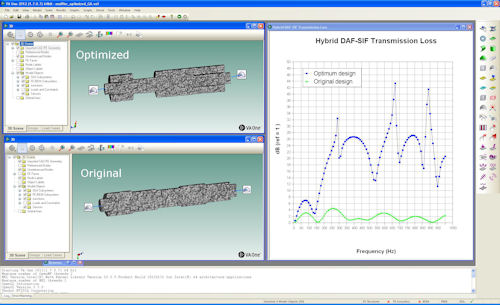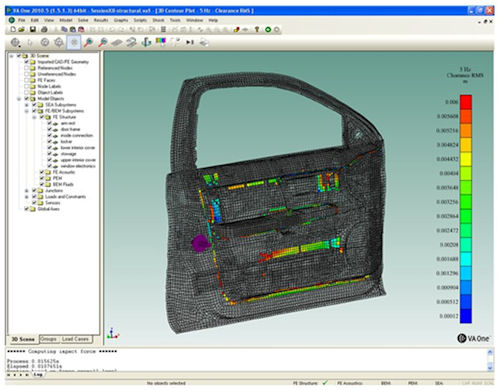Full Frequency Noise and Vibration Simulation
ESI adds design optimization module to VA One 2012 noise and vibration simulation solution.
Latest News
September 5, 2012
By Anthony J. Lockwood
ESI Group (Paris, France) has released the 2012 version of VA One, its solution for simulating noise and vibration across the full frequency range. VA One combines finite elements, boundary elements, and statistical energy analysis (SEA) in a single model within common operating environment. The 2012 release has been enhanced with a design optimization module that is fully integrated within the VA One environment as well as enrichments to the software’s boundary element solvers said to deliver faster solution times.
 |
| A built-in genetic algorithm in VA One 2012 can modify the shape of a muffler to maximize low-frequency acoustic transmission loss automatically. Image courtesy of ESI Group. |
The fully integrated design optimization module in VA One 2012 is intended for engineers seeking to equalize various parameters of a design to meet certain performance goals, such as balancing the interior sound package in transportation applications to reduce mass. Parameter variations, parameter optimizations, and Monte Carlo simulations can be performed quickly and easily using the graphical user interface, says the company. VA One’s intelligent data caching capability also ensures fast solve times when using design optimization, the company adds.
“Optimizing interior sound package is important to meet vehicle cost, noise, weight, and fuel efficiency targets,” said Fumihiko Kosaka, Noise and Vibration Engineer, Mitsubishi Motors Corporation (MMC) in a testimonial supplied by the ESI Group. “VA One is a standard tool for MMC and helps us meet our targets.”
VA One, says the ESI Group, includes built-in support for solving BEM (boundary element method) models in parallel on multi-core desktop machines, remote Linux machines, departmental networks, clusters and clouds. Automotive and aerospace BEM models that previously required overnight execution on standard clusters have been solved in minutes using cloud computing (using over 800 parallel cores, while incurring negligible hardware costs), according to company. A new flexible “surge” licensing option is being piloted in VA One 2012 to support this functionality, the company adds.
 |
| VA One model of BSR propensity for a vehicle door. Image courtesy of ESI Group. |
The BEM solvers have also been enhanced with a new adaptive integration scheme for standard BEM. This is said to result in faster solutions times. Additionally, a new preconditioner and iterative solver for fast multi-pole BEM results in what the company describes as “significant convergence improvements.”
New functionality has also been added to VA One 2012 for editing the attributes of multiple SEA subsystems quickly, according to the company. ESI Group says that this reduces the time required to build and modify SEA models, resulting in significant productivity gains.
Optional extension modules available for VA One include a scripting language for creating custom processes and GUIs, CAD import modules, poroelastic materials, and dynamic stress, strain, and force recovery across structural FE subsystems. For more information on VA One 2012, visit ESI Group.
Watch a testimonial from an engineer at IVECO.
Get details on extension modules for VA One.
See why DE’s editors selected VA one 2012 from the ESI Group as their Pick of the Week.
Sources: Press materials received from the company and additional information gleaned from the company’s website.
Subscribe to our FREE magazine, FREE email newsletters or both!
Latest News
About the Author
Anthony J. Lockwood is Digital Engineering’s founding editor. He is now retired. Contact him via [email protected].
Follow DE





